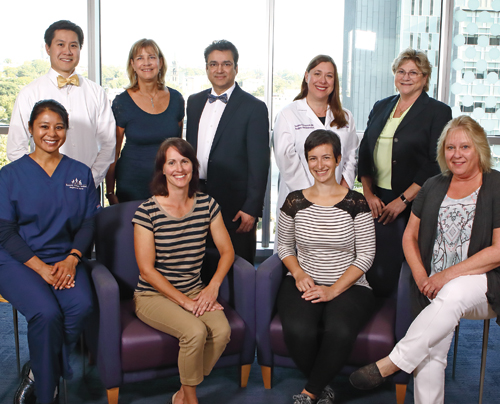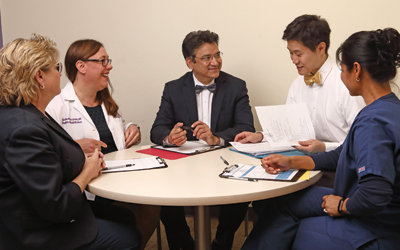By Laura Thornton
Life isn’t easy for kids with chronic, debilitating pain. Without treatment, they’re often forced to sit life out on the sidelines, watching other kids have all the fun. Some kids experience such unbearable pain that they’re unable to walk without assistance or even go to school.
But Kennedy Krieger Institute offers these kids and their families hope. At the Institute’s Pain Rehabilitation Program, clinicians from a variety of fields come together to help kids overcome their pain and get as much normalcy back into their lives as possible.
“Our goal is to help our patients learn to conquer their pain, and not be controlled by it—to help them live their lives again,” says Dr. Suzanne Rybczynski, medical director of the Institute’s inpatient services.
The program provides evaluations, recommendations and treatment for kids who’ve been suffering from debilitating pain for six months or more. The program’s staff includes doctors, nurses, and physical, occupational and cognitive-behavioral therapists, as well as other specialists, making it “interdisciplinary to the core,” says Dr. Irfan Suleman, medical director of the Pain Rehabilitation Program.
The gateway to the program is the Pain Rehabilitation Clinic, explains Mary Burr, the clinic’s nurse practitioner. At the clinic, each child is evaluated by a doctor and a nurse practitioner who specialize in pain, as well as by a cognitive-behavioral therapist and a physical therapist.
The interdisciplinary team approach ensures that no aspect of a child’s pain or care plan—medical, psychological or therapeutic—goes unnoticed. “We’ve found that this individualized, team approach helps us establish trust with the families,” Burr says. “By the time they get to us, families have often been to multiple providers, have received multiple diagnoses, and don’t know whom or what to believe.”
A Plan for Every Patient

Children and teens—the average patient age is 13—arrive at the clinic with, collectively, a host of different pains. All of them demonstrate functional disability—an inability to engage with or execute daily living activities and tasks.
Many of the kids evaluated or treated by the program have complex regional pain syndrome, in which an injury heals but the brain keeps sending out pain signals and the body keeps experiencing the pain of, say, a broken ankle, long after the ankle heals. Some have chronic headaches or abdominal pain. Some cannot move their arms or legs without searing pain running through their bodies. Some wear dark glasses because they’ve been inside for so long that any light hurts their eyes, and many are depressed, explains Dr. Keith Slifer, clinical director of pain psychology services at Kennedy Krieger.
After evaluating a patient, clinic team members gather to determine the child’s best care plan. For some children, the group recommends outpatient physical and cognitive-behavioral therapies, either at Kennedy Krieger’s outpatient center or in patients’ home communities. For others, it's several weeks of intense therapies at either the Institute's inpatient rehabilitation hospital or its Specialized Transition Program Neurorehabilitation Day Hospital. Kids receiving treatment at the day hospital will get to return to their families at night.
The program’s clinicians have found that a vigorous routine of physical, occupational and cognitive-behavioral therapies is crucial to conquering pain. Treatment plans may include physical therapy to strengthen muscles that have weakened from underuse, and occupational therapy to learn new ways to do things without causing the body so much pain. Some children are referred to neurologists, geneticists, gastroenterologists or other specialists for additional evaluation.

For patients experiencing pain from an injury that healed long ago, the team recommends a gradual reengagement—under medical supervision—with regular activities, like brushing their teeth or getting dressed, carefully building up to completing entire activities on their own. This retrains a patient’s brain to interpret physical signals more like it did before injury, reducing the perception of pain, Dr. Slifer explains.
For some children, pain interventions guided by ultrasound or fluoroscopic technology (with the latter, a continuous X-ray beam produces a moving image of the targeted body part on a video monitor) can lessen the pain—or sometimes even eliminate it, explains Dr. Suleman, an anesthesiologist who specializes in pediatric pain. These interventions are performed through Kennedy Krieger’s partnership with Johns Hopkins, and they take place under sedation in the operating room at Johns Hopkins’ children’s center, one of the few hospitals in the country providing such services.
Getting Better
This past summer, Kennedy Krieger’s inpatient rehabilitation hospital provided treatment to several teenage girls who’d been diagnosed with chronic pain. All summer long, they encouraged and motivated each other to keep up with their therapies—they were determined to return to more typical teen activities. Supported by each other and their care team, they all got better.
“I love working with the hospital’s pediatric pain patients,” Dr. Rybczynski says, “because they’re so motivated and they work so hard.
“There’s the real possibility that they will get better,” and very often, they do, “and I love that.”
To learn more about evaluation and treatment options for chronic pain offered at the Institute, visit the Pain Rehabilitation Program page.
